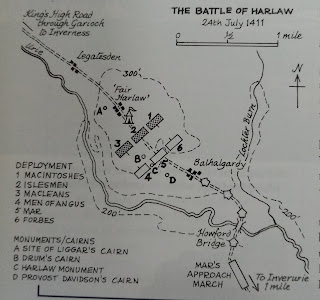The Battle of Harlaw

BATTLE OF HARLAW. Famed in ballad, the Battle of Harlaw was the first great conflict between Lowland and 'Highland' Scotland. The battle itself was over the ownership of the Earldom of Ross, claimed for the Highlands by Donald, second Lord of the Isles. Opposing him was the Lowland Stewart dynasty under the Duke of Albany. Armed conflict was the only option as King James I, who might have been able to arbitrate, was being held captive in England. Donald, who regarded himself as an independent ruler, had English help. He was probably also supported by the captive Scottish king, who was increasingly dismayed at the waywardness of his Stewart relatives. Although Donald's real purpose was to secure the eastern lands of the Earldom of Ross, he seems to have planned to pillage Aberdeen and th surrounding area as a means of weakening the Stewart earls. The power and prestige of the Lord of the Isles at that time was shown by the size of Donald's army at Harlaw - perhaps as ma...





